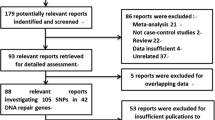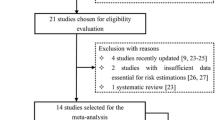Abstract
Several single nucleotide polymorphisms (SNPs) affecting DNA repair capacity and modifying cancer susceptibility have been described. We evaluated the association of SNPs Arg194Trp, Arg280His, and Arg399Gln in the X-ray cross-complementing group 1 (XRCC1) and Thr241Met in the X-ray cross-complementing group 3 (XRCC3) DNA repair genes with the risk of brain tumors. The Caucasian study population consisted of 701 glioma (including 320 glioblastoma) cases, 524 meningioma cases, and 1,560 controls in a prospective population-based case–control study conducted in Denmark, Finland, Sweden, and the UK. The studied SNPs were not significantly associated with the risk of brain tumors. The highest odds ratios (ORs) for the associations were observed between the homozygous variant genotype XRCC1 Gln399Gln and the risk of glioma (OR = 1.32; 95% confidence interval, CI, 0.97–1.81), glioblastoma (OR = 1.48; 95% CI, 0.98–2.24), and meningioma (OR = 1.34; 95% CI, 0.96–1.86). However, in pair-wise comparisons a few SNP combinations were associated with the risk of brain tumors: Among others, carriers of both homozygous variant genotypes, i.e., XRCC1 Gln399Gln and XRCC3 Met241Met, were associated with a three-fold increased risk of glioma (OR = 3.18; 95% CI, 1.26–8.04) and meningioma (OR = 2.99; 95% CI, 1.16–7.72). In conclusion, no significant association with brain tumors was found for any of the polymorphisms, when examined one by one. Our results indicated possible associations between combinations of XRCC1 and XRCC3 SNPs and the risk of brain tumors.
Similar content being viewed by others
References
Ron E, Modan B, Boice JD Jr et al (1988) Tumors of the brain and nervous system after radiotherapy in childhood. N Engl J Med 319:1033–1039
Sadetzki S, Chetrit A, Freedman L et al (2005) Long-term follow-up for brain tumour development after childhood exposure to ionising radiation for tinea capitis. Radiat Res 163:424–432
Goode EL, Ulrich CM, Potter JD (2002) Polymorphisms in DNA repair genes and associations with cancer risk. Cancer Epidemiol Biomarkers Prev 11:1513–1530
Hung RJ, Hall J, Brennan P et al (2005) Genetic polymorphisms in the base excision repair pathways and cancer risk: a HuGE review. Am J Epidemiology 162:925–942
Audebert M, Salles B, Calsou P (2004) Involvement of poly(ADP-ribose)polymerase-1 and XRCC1/DNA ligase III in an alternative route for DNA double-strand breaks rejoining. J Biol Chem 279:55117–55126
Shen MR, Jones IM, Mohrenweiser H (1998) Nonconservative amino acid substitution variants exist at polymorphic frequency in DNA repair genes in healthy humans. Cancer Res 58:604–608
Thompson LH, Schild D (2002) Recombinational DNA repair and human disease. Mutat Res 509:49–78
Khanna KK, Jackson SP (2001) DNA double-strand breaks: signaling, repair, and the cancer connection. Nat Genet 27:247–254
Bishop DK, Ear U, Bhattacharyya A et al (1998) XRCC3 is required for assembly of Rad51 complexes in vivo. J Biol Chem 273:21482–21488
Pierce AJ, Johnson RD, Thompson LH et al (1999) XRCC3 promotes homology-directed repair of DNA damage in mammalian cells. Genes Dev 23:2633–2638
Caldecott K, Jeggo P (1991) Cross-sensitivity of gamma-ray-sensitive hamster mutants to cross-linking agents. Mutat Res 255:111–121
Wang L-E, Bondy ML, Shen H et al (2004) Polymorphisms of DNA repair genes and risk of glioma. Cancer Res 64:5560–5563
Felini MJ, Olshan AF, Schroeder JC et al (2007) DNA repair polymorphisms XRCC1 and MGMT and risk of adult gliomas. Neuroepidemiology 29:55–58
Sadetzki S, Flint-Richter P, Starinsky S et al (2005) Genotyping of patients with sporadic and radiation-associated meningiomas. Cancer Epidemiol Biomarkers Prev 14:969–976
Cardis E, Richardson L, Deltour I et al (2007) The INTERPHONE study: design, epidemiological methods, and description of the study population. Eur J Epidemiol 22:647–664
Au WW, Navasumrit P, Ruchirawat M (2004) Use of biomarkers to characterize functions of polymorphic DNA repair genotypes. Int J Hyg Environ Health 207:301–313
Kiuru A, Lindholm C, Heilimo I et al (2005) Influence of DNA repair gene polymorphisms on the yield of chromosomal aberrations. Environ Mol Mutagen 46:198–205
Schaid DJ, Rowland CM, Tines DE et al (2002) Score tests for association between traits and haplotypes when linkage phase is ambiguous. Am J Hum Genet 70:425–434
Matullo G, Guarrera S, Carturan S et al (2001) DNA repair gene polymorphisms, bulky DNA adducts in white blood cells and bladder cancer in a case–control study. Int J Cancer 92:562–567
Smith TR, Miller MS, Lohman K et al (2003) Polymorphisms of XRCC1 and XRCC3 genes and susceptibility to breast cancer. Cancer Lett 190:183–190
Wacholder S, Chanock S, Garcia-Closas M et al (2004) Assessing the probability that a positive report is false: an approach for molecular epidemiology studies. J Natl Cancer Inst 96:434–442
Hattersley AT, McCarthy MI (2005) What makes a good genetic association study? Lancet 366:1315–1323
Wacholder S, Rothman N, Caporaso N (2000) Population stratification in epidemiologic studies of common variants and cancer: quantification of bias. J Natl Cancer Inst 92:1151–1158
Wrensch M, Wiencke JK, Wiemels J et al (2006) Serum IgE, tumor epidermal growth factor receptor expression, and inherited polymorphisms associated with glioma survival. Cancer Res 66:4531–4541
Lahkola A, Auvinen A, Raitanen J et al (2007) Mobile phone use and risk of glioma in 5 North European countries. Int J Cancer 120:1769–1775
Acknowledgements
The authors warmly thank all patients, controls, interviewers, and team collaborators in the study in all the participating countries, as listed in Lahkola et al. [25] for their invaluable contribution to this work. This research was supported by a grant from the Nordic Cancer Union. The INTERPHONE Study was supported by the European Commission Fifth Framework Program “Quality of Life and Management of Living Resources” (contract number QLK4-CT-1999–01563), and the International Union against Cancer (UICC; RCA/01/08). The UICC received funds for this study from the Mobile Manufacturers’ Forum and the Global System for Mobile Communications Association. Provision of funds to the INTERPHONE Study investigators via the UICC was governed by agreements that guaranteed INTERPHONE’s complete scientific independence. These agreements are publicly available at INTERPHONE site (2005) (International Agency for Research on Cancer. http://www.iarc.fr/ENG/Units/RCAd.html). Additional support was given by the Academy of Finland (grant number 71037), the Cancer Foundation of Northern Sweden, the Cancer Society of Finland, the Danish Cancer Society, the Emil Aaltonen Foundation, the Mobile Telecommunications and Health Research (MTHR) Program, the Swedish Cancer Society, and the Swedish Research Council. The views expressed in this paper are not necessarily those of the funders.
Author information
Authors and Affiliations
Corresponding author
Rights and permissions
About this article
Cite this article
Kiuru, A., Lindholm, C., Heinävaara, S. et al. XRCC1 and XRCC3 variants and risk of glioma and meningioma. J Neurooncol 88, 135–142 (2008). https://doi.org/10.1007/s11060-008-9556-y
Received:
Accepted:
Published:
Issue Date:
DOI: https://doi.org/10.1007/s11060-008-9556-y




